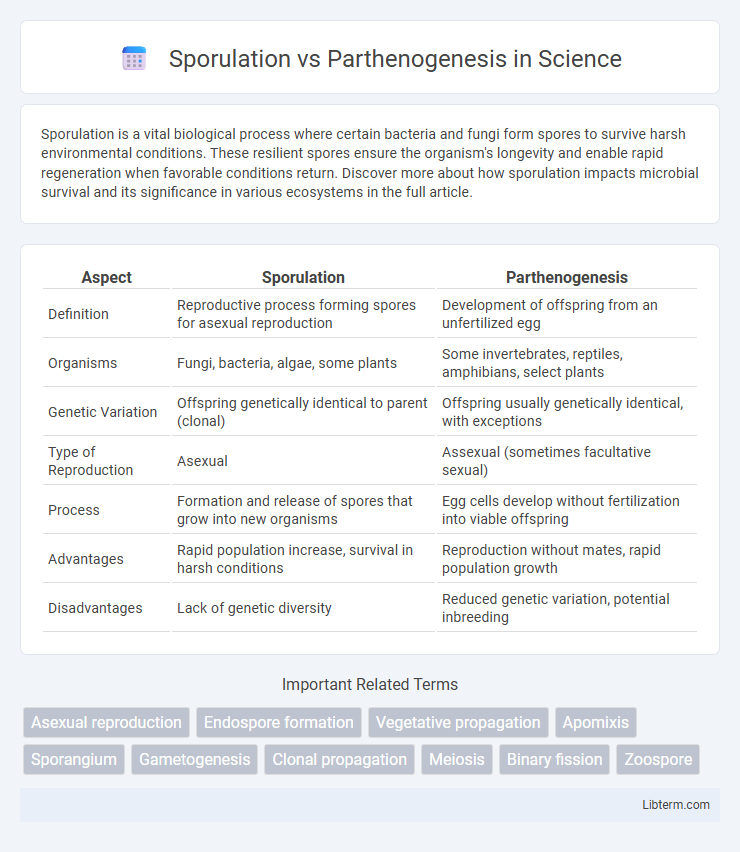Sporulation is a vital biological process where certain bacteria and fungi form spores to survive harsh environmental conditions. These resilient spores ensure the organism's longevity and enable rapid regeneration when favorable conditions return. Discover more about how sporulation impacts microbial survival and its significance in various ecosystems in the full article.
Table of Comparison
| Aspect | Sporulation | Parthenogenesis |
|---|---|---|
| Definition | Reproductive process forming spores for asexual reproduction | Development of offspring from an unfertilized egg |
| Organisms | Fungi, bacteria, algae, some plants | Some invertebrates, reptiles, amphibians, select plants |
| Genetic Variation | Offspring genetically identical to parent (clonal) | Offspring usually genetically identical, with exceptions |
| Type of Reproduction | Asexual | Assexual (sometimes facultative sexual) |
| Process | Formation and release of spores that grow into new organisms | Egg cells develop without fertilization into viable offspring |
| Advantages | Rapid population increase, survival in harsh conditions | Reproduction without mates, rapid population growth |
| Disadvantages | Lack of genetic diversity | Reduced genetic variation, potential inbreeding |
Definition of Sporulation
Sporulation is a biological process in which an organism forms spores, specialized reproductive cells capable of surviving harsh environmental conditions and facilitating asexual reproduction. Spores generated through sporulation can germinate into new individuals without the need for fertilization. In contrast, parthenogenesis involves the development of an embryo from an unfertilized egg, representing another form of asexual reproduction but differing fundamentally in mechanism and cellular origin.
Definition of Parthenogenesis
Parthenogenesis is a form of asexual reproduction where an embryo develops from an unfertilized egg, occurring naturally in some plants, invertebrates, and a few vertebrates. Unlike sporulation, which involves spore formation for reproduction and dispersal, parthenogenesis bypasses fertilization, leading to offspring genetically identical to the mother. This reproductive strategy enables rapid population growth without the need for male gametes.
Biological Significance of Sporulation
Sporulation plays a crucial role in the survival and propagation of certain microorganisms, ensuring genetic stability and resilience under adverse environmental conditions. It enables the formation of durable spores that can withstand extreme heat, desiccation, and chemical damage, facilitating long-term dormancy until favorable growth conditions return. In contrast to parthenogenesis, which involves asexual reproduction in multicellular organisms, sporulation is primarily a microbial strategy for stress resistance and population dispersal.
Biological Significance of Parthenogenesis
Parthenogenesis is a form of asexual reproduction where offspring develop from unfertilized eggs, providing a rapid means of population increase and genetic continuity in stable environments. Unlike sporulation, which generates spores for dispersal and survival under adverse conditions, parthenogenesis ensures immediate reproduction without the need for a mate, enhancing species survival in isolated or low-density populations. This reproductive strategy is observed in various invertebrates, reptiles, and plants, contributing to evolutionary adaptability and ecological success.
Mechanisms Involved in Sporulation
Sporulation involves the formation of spores through a complex cellular process where a single cell undergoes division and differentiation to produce resistant, dormant structures capable of surviving adverse conditions. Key mechanisms include DNA replication, cytoplasmic partitioning, and formation of a protective spore coat composed of specialized proteins and polysaccharides. Unlike parthenogenesis, which is an asexual reproductive process resulting in offspring from an unfertilized egg, sporulation primarily functions for survival and dispersal in fungi, bacteria, and certain protists.
Mechanisms Involved in Parthenogenesis
Parthenogenesis involves the development of an embryo from an unfertilized egg through mechanisms such as automixis, where meiosis occurs followed by the fusion of haploid nuclei, or apomixis, which bypasses meiosis entirely to produce diploid eggs. In contrast to sporulation, which relies on spore formation through mitotic or meiotic division in fungi or bacteria, parthenogenesis in animals bypasses fertilization by using cellular processes to maintain diploidy and initiate embryogenesis. Key molecular pathways in parthenogenesis include the activation of calcium ion fluxes and alterations in gene expression to mimic fertilization signals, enabling the egg cell to commence development autonomously.
Examples of Organisms Utilizing Sporulation
Sporulation is a reproductive strategy used by organisms such as fungi, bacteria, and some algae, including examples like Bacillus species, Penicillium fungi, and Rhizopus molds. These organisms produce spores that can withstand harsh environmental conditions and facilitate dispersal. In contrast, parthenogenesis occurs in species like aphids, certain lizards, and some sharks, where development proceeds from unfertilized eggs without spore formation.
Examples of Organisms Reproducing via Parthenogenesis
Parthenogenesis is a form of asexual reproduction where offspring develop from unfertilized eggs, commonly observed in organisms such as aphids, honeybees, and certain reptiles like the Komodo dragon. In contrast to sporulation, which occurs in fungi and some bacteria through spore formation, parthenogenesis enables animals to reproduce without male fertilization, ensuring population survival in the absence of mates. This reproductive strategy is particularly advantageous in stable environments where genetic variation is less critical for survival.
Advantages and Disadvantages: Sporulation vs Parthenogenesis
Sporulation enables rapid reproduction through spores, allowing organisms like fungi and algae to colonize environments efficiently but often results in genetically identical offspring, limiting genetic diversity. Parthenogenesis, seen in some reptiles and insects, produces offspring without fertilization, ensuring reproduction in the absence of mates but may increase vulnerability to environmental changes due to reduced genetic variability. Both methods offer reproductive advantages in specific contexts, with sporulation favoring dispersal and survival under harsh conditions, while parthenogenesis supports population maintenance when mates are scarce.
Ecological and Evolutionary Implications
Sporulation enables organisms such as fungi and bacteria to produce resistant spores that enhance survival in harsh ecological conditions, promoting rapid colonization and genetic stability across generations. Parthenogenesis, observed in some plants and animals, allows for reproduction without fertilization, facilitating population maintenance in isolated or low-density environments while reducing genetic diversity. These reproductive strategies reflect evolutionary adaptations balancing survival, dispersal, and genetic variability in response to environmental pressures.
Sporulation Infographic

 libterm.com
libterm.com